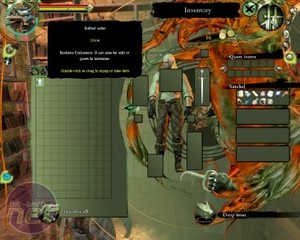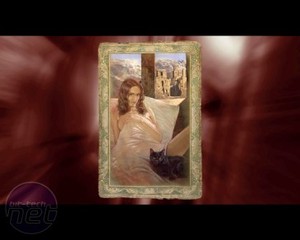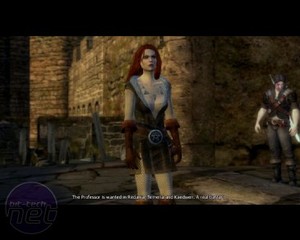Cast a spell on you
As soon as players get control of Geralt they are plunged into the action, which immediately sets the tone for the rest of the game. While there are opportunities in some quests to solve things through dialogue, the vast majority of the game is focused on the combat. That’s to be expected though, Geralt is a monster hunter after all, not a monster annoyer.The game can be controlled from two different viewpoints and in two different ways, both of which you can (and should) switch between at any point. The first method of control is the isometric and mouse method, which puts the camera up high and gives you the most fluid control via the mouse. Click to go here, click to use that – run of the mill RPG control.
The second method is the over-the-shoulder camera, which does exactly what it says on the tin. This method lends itself more to keyboard players and you’ll be moving around mainly with WASD. In both viewpoints you can use either method, so if you want to use the mouse in the OST viewpoint then you can and vice versa.
Just as we said in the introduction though, though the twin control methods are good in premise, it doesn’t necessarily mean that they work in practice. That’s pretty much the case here, with neither method feeling that it works all that well and it being plainly obvious that the game wasn’t designed to be played exclusively through either method. The result is that you have to switch between the two constantly, using isometric views for large battles and outside areas and the OST view for tête-à-têtes battles and indoor areas.
Now, as I said before, The Witcher is a very combat-orientated RPG and the way the combat is handled in the game is actually quite interesting though a little difficult to explain.
Geralt is a skilled fighter and can use a selection of different styles of attack, which must carefully be matched to the enemy. Strong enemies will ignore light attacks and fast enemies will avoid slower, more powerful ones, so learning how to use the three styles is pivotal.
What makes the combat most interesting though is how not-boring it is which, I agree, is an odd thing to say. To attack someone in The Witcher all you have to do is click on them. One click is equal to one attack. You can’t just click away though because timing your clicks wrong will end your current attack and start another – repetitive clicking won’t attack at all. To stop combat being dull, Geralt can perform combos by attacking just as the first attack finishes and the cursor bursts into flames – a window of a second or two.
Now, that sounds boring because it means you’d just end up seeing the same moves over and over, timing your clicks just right every time. To combat this though (sorry) you can use your XP to buy new attacks. These new attacks can either be new moves, such as making your first attack a more powerful slash, or can be extra attacks in the chain, allowing you to combo for longer. This, combined with the focus on combat and the pace of the game, means that the attacks you use will often change.
Geralt can use spells too, but to be honest there isn’t anything new in the spells and the selection isn’t that impressive compared to other RPGs.
One of the other most-discussed features in The Witcher is the sex, which features prominently throughout the game and harks back to games like The Bards Tale. Ah, the memories. The way it works is this; various women throughout the game have certain, um…well, let’s call them ‘win scenarios’. For some women, such as Triss the Witcher sorceress, it can be as simple as being nice to her for a bit, while others may require you to complete a quest or to pay them in advance. There are whores aplenty in this game.
Either way, once you’ve ‘won’ then you’ll be treated to short cutscene. The cutscene itself is usually pretty tame – a shot of some bare feet and the clothes on the floor – and won’t get you hot unless you really like that kind of thing. Afterwards you’re given a tarot card with a picture of the encounter on it – which tends to be a bit saucier but still never gets really full-on.
Basically; boobs but no bush is what I’m getting at here, which is worth bearing in mind if this is on your kids' Christmas list. Anyway, there’s more steamy polygon-on-polygon action on the next page, so let’s move on.

MSI MPG Velox 100R Chassis Review
October 14 2021 | 15:04














Want to comment? Please log in.